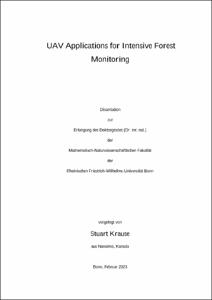UAV Applications for Intensive Forest Monitoring

UAV Applications for Intensive Forest Monitoring

| dc.contributor.advisor | Greve, Klaus | |
| dc.contributor.author | Krause, Stuart | |
| dc.date.accessioned | 2024-02-26T13:32:30Z | |
| dc.date.available | 2024-02-26T13:32:30Z | |
| dc.date.issued | 26.02.2024 | |
| dc.identifier.uri | https://hdl.handle.net/20.500.11811/11343 | |
| dc.description.abstract | Intensive forest monitoring at Level II plots in Europe necessitates standardization for observing and measuring forest parameters, allowing for comprehensive assessments across various scales. The harmonization of these data is crucial, especially when integrating with remote sensing (RS) Earth Observation platforms like Sentinels and Landsat. Despite the challenges of translating ground-based data to represent diverse forests and the high costs of systematic field campaigns, recent advancements in Unmanned Aerial Vehicle-Remote Sensing (UAV-RS) technology offer high-resolution, temporally frequent data acquisition. This technology enables enhanced forest measurements, such as tree height and crown diameter, and improves observations in phenology and tree health. UAV-RS can potentially replace traditional ground observations in certain cases and extend monitoring to include additional forest types representative of a region.
This dissertation investigates the potential of UAV-RS to enhance or replace traditional ground observations at forest monitoring plots. Three research questions are explored: the accuracy of UAV-based photogrammetric tree height extraction compared to traditional methods, the effectiveness of UAV thermal imaging in detecting drought stress in Beech trees, and the reliability of UAV-derived machine learning models for phenological assessments. The studies reveal that UAV-RS can provide accurate tree height measurements, detect drought stress using thermal imaging, and predict phenological phases using multispectral indices and machine learning. However, challenges such as radiometric calibration, thermal imaging error propagation, and translating ground observations to remote sensing data need further research. The dissertation concludes that UAV-RS will likely become a key component of future forest monitoring, but coordinated efforts and standardization are essential for its effective integration. | en |
| dc.language.iso | eng | |
| dc.rights | In Copyright | |
| dc.rights.uri | http://rightsstatements.org/vocab/InC/1.0/ | |
| dc.subject | UAV | |
| dc.subject | Fernerkundung | |
| dc.subject | forstliche Monitoring | |
| dc.subject | Remote Sensing | |
| dc.subject | Forest Monitoring | |
| dc.subject.ddc | 910 Geografie, Reisen | |
| dc.title | UAV Applications for Intensive Forest Monitoring | |
| dc.type | Dissertation oder Habilitation | |
| dc.identifier.doi | https://doi.org/10.48565/bonndoc-232 | |
| dc.publisher.name | Universitäts- und Landesbibliothek Bonn | |
| dc.publisher.location | Bonn | |
| dc.rights.accessRights | openAccess | |
| dc.identifier.urn | https://nbn-resolving.org/urn:nbn:de:hbz:5-74361 | |
| ulbbn.pubtype | Erstveröffentlichung | |
| ulbbnediss.affiliation.name | Rheinische Friedrich-Wilhelms-Universität Bonn | |
| ulbbnediss.affiliation.location | Bonn | |
| ulbbnediss.thesis.level | Dissertation | |
| ulbbnediss.dissID | 7436 | |
| ulbbnediss.date.accepted | 22.11.2023 | |
| ulbbnediss.institute | Mathematisch-Naturwissenschaftliche Fakultät : Fachgruppe Erdwissenschaften / Geographisches Institut | |
| ulbbnediss.fakultaet | Mathematisch-Naturwissenschaftliche Fakultät | |
| dc.contributor.coReferee | Malenovsky, Zbynek | |
| ulbbnediss.contributor.orcid | https://orcid.org/0000-0003-1553-4710 |
Files in this item
This item appears in the following Collection(s)
-
E-Dissertationen (4077)




